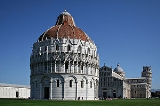
Campo dei Miracoli
Encyclopedia


Pisa
Pisa is a city in Tuscany, Central Italy, on the right bank of the mouth of the River Arno on the Tyrrhenian Sea. It is the capital city of the Province of Pisa...
, Tuscany
Tuscany
Tuscany is a region in Italy. It has an area of about 23,000 square kilometres and a population of about 3.75 million inhabitants. The regional capital is Florence ....
, Italy
Italy
Italy , officially the Italian Republic languages]] under the European Charter for Regional or Minority Languages. In each of these, Italy's official name is as follows:;;;;;;;;), is a unitary parliamentary republic in South-Central Europe. To the north it borders France, Switzerland, Austria and...
, recognized as one of the main centers for medieval art in the world. Partly paved and partly grassed, it is dominated by four great religious edifices: the Duomo
Duomo
Duomo is a term for a cathedral church. The formal word for a church that is presently a cathedral is cattedrale; a Duomo may be either a present or a former cathedral . Some, like the Duomo of Monza, have never been cathedrals, although old and important...
(cathedral), the Campanile
Leaning Tower of Pisa
The Leaning Tower of Pisa or simply the Tower of Pisa is the campanile, or freestanding bell tower, of the cathedral of the Italian city of Pisa...
(the cathedral's free standing bell tower
Campanile
Campanile is an Italian word meaning "bell tower" . The term applies to bell towers which are either part of a larger building or free-standing, although in American English, the latter meaning has become prevalent.The most famous campanile is probably the Leaning Tower of Pisa...
), the Baptistry
Baptistry (Pisa)
The Baptistry of St. John is a religious building in Pisa, Italy. It started construction in 1152, in replacement of an older baptistry, and completed in 1363...
and the Camposanto
Camposanto Monumentale
The Campo Santo, also known as Camposanto Monumentale or Camposanto Vecchio , is a historical edifice at the northern edge of the Cathedral Square in Pisa, Italy....
.
It is otherwise known as Piazza dei Miracoli ("Square of Miracles"). This name was created by the Italian writer and poet Gabriele d'Annunzio
Gabriele D'Annunzio
Gabriele D'Annunzio or d'Annunzio was an Italian poet, journalist, novelist, and dramatist...
who, in his novel Forse che si forse che no (1910) described the square in this way:
which means: "The Ardea rotated over the sky of Christ, over the meadow of Miracles."
Often people tend to mistake the term with Campo dei Miracoli ("Field of Miracles"). This one is a fictional magical field in the book Pinocchio
Pinocchio
The Adventures of Pinocchio is a novel for children by Italian author Carlo Collodi, written in Florence. The first half was originally a serial between 1881 and 1883, and then later completed as a book for children in February 1883. It is about the mischievous adventures of Pinocchio , an...
, where a gold coin seed will grow a money tree.
In 1987 the whole square was declared a UNESCO
UNESCO
The United Nations Educational, Scientific and Cultural Organization is a specialized agency of the United Nations...
World Heritage Site
World Heritage Site
A UNESCO World Heritage Site is a place that is listed by the UNESCO as of special cultural or physical significance...
.
Duomo
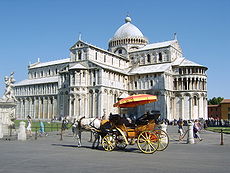
Cathedral
A cathedral is a Christian church that contains the seat of a bishop...
, entitled to Santa Maria Assunta (St. Mary of the Assumption). This is a five-naved cathedral with a three-naved transept. The church is known also as the Primatial, the archbishop of Pisa being a Primate
Primate (religion)
Primate is a title or rank bestowed on some bishops in certain Christian churches. Depending on the particular tradition, it can denote either jurisdictional authority or ceremonial precedence ....
since 1092.
Construction was begun in 1064 by the architect Busketo, and set the model for the distinctive Pisan Romanesque
Romanesque architecture
Romanesque architecture is an architectural style of Medieval Europe characterised by semi-circular arches. There is no consensus for the beginning date of the Romanesque architecture, with proposals ranging from the 6th to the 10th century. It developed in the 12th century into the Gothic style,...
style of architecture. The mosaics of the interior, as well as the pointed arches, show a strong Byzantine
Byzantine Empire
The Byzantine Empire was the Eastern Roman Empire during the periods of Late Antiquity and the Middle Ages, centred on the capital of Constantinople. Known simply as the Roman Empire or Romania to its inhabitants and neighbours, the Empire was the direct continuation of the Ancient Roman State...
influence.
The façade, of grey marble
Marble
Marble is a metamorphic rock composed of recrystallized carbonate minerals, most commonly calcite or dolomite.Geologists use the term "marble" to refer to metamorphosed limestone; however stonemasons use the term more broadly to encompass unmetamorphosed limestone.Marble is commonly used for...
and white stone set with discs of coloured marble, was built by a master named Rainaldo, as indicated by an inscription above the middle door: Rainaldus prudens operator.
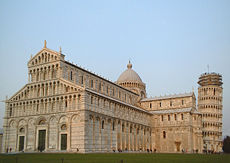
Bronze
Bronze is a metal alloy consisting primarily of copper, usually with tin as the main additive. It is hard and brittle, and it was particularly significant in antiquity, so much so that the Bronze Age was named after the metal...
main doors were made in the workshops of Giambologna
Giambologna
Giambologna, born as Jean Boulogne, incorrectly known as Giovanni da Bologna and Giovanni Bologna , was a sculptor, known for his marble and bronze statuary in a late Renaissance or Mannerist style.- Biography :...
, replacing the original doors destroyed in a fire in 1595. The central door was in bronze and made around 1180 by Bonanno Pisano, while the other two were probably in wood.
However worshippers never used the façade doors to enter, instead entering by way of the Porta di San Ranieri (St. Ranieri's Door), in front of the Leaning Tower, made in around 1180 by Bonanno Pisano
Bonanno Pisano
Bonanno Pisano , active in the 1170s and 1180s, was an Italian sculptor, mixing Byzantine and classical elements. Giorgio Vasari wrongly attributed the realisation of the Leaning Tower of Pisa to him in his Vite. Pisano was born in Pisa and worked there most of his life...
.
Above the doors there are four rows of open galleries with, on top, statues of Madonna with Child and, on the corners, the Four evangelists.
Also in the façade we can find the tomb of Busketo (on the left side) and an inscription about the foundation of the Cathedral and the victorious battle against Saracen
Saracen
Saracen was a term used by the ancient Romans to refer to a people who lived in desert areas in and around the Roman province of Arabia, and who were distinguished from Arabs. In Europe during the Middle Ages the term was expanded to include Arabs, and then all who professed the religion of Islam...
s.
At the east end of the exterior, high on a column rising from the gable
Gable
A gable is the generally triangular portion of a wall between the edges of a sloping roof. The shape of the gable and how it is detailed depends on the structural system being used and aesthetic concerns. Thus the type of roof enclosing the volume dictates the shape of the gable...
is a modern replica of the Pisa Griffin
Pisa Griffin
The Pisa Griffin is a large bronze sculpture of a griffin, a mythical beast, which has been in Pisa in Italy since the Middle Ages, though it is of Islamic origin. It is the largest medieval Islamic metal sculpture known, at over three feet tall , and was probably created in the 11th century in...
, the largest Islamic metal sculpture
Islamic art
Islamic art encompasses the visual arts produced from the 7th century onwards by people who lived within the territory that was inhabited by or ruled by culturally Islamic populations...
known, the original of which was placed there probably in the 11th or 12th century, and is now in the Cathedral Museum.
The interior is faced with black and white marble and has a gild
Gilding
The term gilding covers a number of decorative techniques for applying fine gold leaf or powder to solid surfaces such as wood, stone, or metal to give a thin coating of gold. A gilded object is described as "gilt"...
ed ceiling and a fresco
Fresco
Fresco is any of several related mural painting types, executed on plaster on walls or ceilings. The word fresco comes from the Greek word affresca which derives from the Latin word for "fresh". Frescoes first developed in the ancient world and continued to be popular through the Renaissance...
ed dome
Dome
A dome is a structural element of architecture that resembles the hollow upper half of a sphere. Dome structures made of various materials have a long architectural lineage extending into prehistory....
. It was largely redecorated after a fire in 1595, which destroyed most of the medieval art works.
Fortunately, the impressive mosaic
Mosaic
Mosaic is the art of creating images with an assemblage of small pieces of colored glass, stone, or other materials. It may be a technique of decorative art, an aspect of interior decoration, or of cultural and spiritual significance as in a cathedral...
, in the apse
Apse
In architecture, the apse is a semicircular recess covered with a hemispherical vault or semi-dome...
, of Christ in Majesty, flanked by the Blessed Virgin and St. John the Evangelist, survived the fire. It evokes the mosaics in the church of Monreale
Monreale
Monreale is a town and comune in the province of Palermo, in Sicily, Italy, on the slope of Monte Caputo, overlooking the very fertile valley called "La Conca d'oro" , famed for its orange, olive and almond trees, the produce of which is exported in large quantities...
, Sicily
Sicily
Sicily is a region of Italy, and is the largest island in the Mediterranean Sea. Along with the surrounding minor islands, it constitutes an autonomous region of Italy, the Regione Autonoma Siciliana Sicily has a rich and unique culture, especially with regard to the arts, music, literature,...
. Although it is said that the mosaic was done by Cimabue
Cimabue
Cimabue , also known as Bencivieni di Pepo or in modern Italian, Benvenuto di Giuseppe, was an Italian painter and creator of mosaics from Florence....
, only the head of St. John was done by the artist in 1302 and was his last work, since he died in Pisa in the same year. The cupola, at the intersection of the nave
Nave
In Romanesque and Gothic Christian abbey, cathedral basilica and church architecture, the nave is the central approach to the high altar, the main body of the church. "Nave" was probably suggested by the keel shape of its vaulting...
and the transept
Transept
For the periodical go to The Transept.A transept is a transverse section, of any building, which lies across the main body of the building. In Christian churches, a transept is an area set crosswise to the nave in a cruciform building in Romanesque and Gothic Christian church architecture...
, was decorated by Riminaldi showing the ascension of the Blessed Virgin.
Galileo
Galileo Galilei
Galileo Galilei , was an Italian physicist, mathematician, astronomer, and philosopher who played a major role in the Scientific Revolution. His achievements include improvements to the telescope and consequent astronomical observations and support for Copernicanism...
is believed to have formulated his theory about the movement of a pendulum
Pendulum
A pendulum is a weight suspended from a pivot so that it can swing freely. When a pendulum is displaced from its resting equilibrium position, it is subject to a restoring force due to gravity that will accelerate it back toward the equilibrium position...
by watching the swinging of the incense
Incense
Incense is composed of aromatic biotic materials, which release fragrant smoke when burned. The term "incense" refers to the substance itself, rather than to the odor that it produces. It is used in religious ceremonies, ritual purification, aromatherapy, meditation, for creating a mood, and for...
lamp (not the present one) hanging from the ceiling of the nave
Nave
In Romanesque and Gothic Christian abbey, cathedral basilica and church architecture, the nave is the central approach to the high altar, the main body of the church. "Nave" was probably suggested by the keel shape of its vaulting...
. That lamp, smaller and simpler than the present one, it is now kept in the Camposanto, in the Aulla chapel.
The impressive granite Corinthian columns between the nave and the aisle came originally from the mosque
Mosque
A mosque is a place of worship for followers of Islam. The word is likely to have entered the English language through French , from Portuguese , from Spanish , and from Berber , ultimately originating in — . The Arabic word masjid literally means a place of prostration...
of Palermo
Palermo
Palermo is a city in Southern Italy, the capital of both the autonomous region of Sicily and the Province of Palermo. The city is noted for its history, culture, architecture and gastronomy, playing an important role throughout much of its existence; it is over 2,700 years old...
, captured by the Pisans in 1063.
The coffer ceiling
Coffer
A coffer in architecture, is a sunken panel in the shape of a square, rectangle, or octagon in a ceiling, soffit or vault...
of the nave was replaced after the fire of 1595. The present gold-decorated ceiling carries the coat of arms of the Medici
Medici
The House of Medici or Famiglia de' Medici was a political dynasty, banking family and later royal house that first began to gather prominence under Cosimo de' Medici in the Republic of Florence during the late 14th century. The family originated in the Mugello region of the Tuscan countryside,...
.
The elaborately carved pulpit
Pulpit
Pulpit is a speakers' stand in a church. In many Christian churches, there are two speakers' stands at the front of the church. Typically, the one on the left is called the pulpit...
(1302–1310), which also survived the fire, was made by Giovanni Pisano
Giovanni Pisano
Giovanni Pisano was an Italian sculptor, painter and architect. Son of the famous sculptor Nicola Pisano, he received his training in the workshop of his father....
and is one the masterworks of medieval sculpture. It was packed away during the redecoration and was not rediscovered and re-erected until 1926. The pulpit is supported by plain columns (two of which mounted on lions sculptures) on one side and by caryatid
Caryatid
A caryatid is a sculpted female figure serving as an architectural support taking the place of a column or a pillar supporting an entablature on her head. The Greek term karyatides literally means "maidens of Karyai", an ancient town of Peloponnese...
s and a telamon
Telamon
In Greek mythology, Telamon , son of the king Aeacus, of Aegina, and Endeis and brother of Peleus, accompanied Jason as one of his Argonauts, and was present at the hunt for the Calydonian Boar. In the Iliad he was the father of Greek heroes Ajax the Great and Teucer the Archer by different...
on the other: the latter represent St. Michael, the Evangelists, the four cardinal virtues
Cardinal virtues
In Christian traditionthere are 4 cardinal virtues:*Prudence - able to judge between actions with regard to appropriate actions at a given time*Justice - proper moderation between self-interest and the rights and needs of others...
flanking the Church, and a bold, naturalistic depiction of a naked Hercules
Hercules
Hercules is the Roman name for Greek demigod Heracles, son of Zeus , and the mortal Alcmene...
. A central plinth
Plinth
In architecture, a plinth is the base or platform upon which a column, pedestal, statue, monument or structure rests. Gottfried Semper's The Four Elements of Architecture posited that the plinth, the hearth, the roof, and the wall make up all of architectural theory. The plinth usually rests...
with the liberal arts
Liberal arts
The term liberal arts refers to those subjects which in classical antiquity were considered essential for a free citizen to study. Grammar, Rhetoric and Logic were the core liberal arts. In medieval times these subjects were extended to include mathematics, geometry, music and astronomy...
supports the four theological virtues
Theological virtues
Theological virtues - in theology and Christian philosophy, are the character qualities associated with salvation, resulting from the grace of God, which enlightens human mind.- In the Bible :The three theological virtues are:...
.
The present day reconstruction of the pulpit is not the correct one. Now it lies not in the same original position, that was nearer the main altar, and the disposition of the columns and the panels are not the original ones. Also the original stairs (maybe in marble) were lost.
The upper part has nine panels dramatic showing scenes from the New Testament, carved in white marble with a chiaroscuro
Chiaroscuro
Chiaroscuro in art is "an Italian term which literally means 'light-dark'. In paintings the description refers to clear tonal contrasts which are often used to suggest the volume and modelling of the subjects depicted"....
effect and separated by figures of prophets: Annunciation, Massacre of the Innocents
Massacre of the Innocents
The Massacre of the Innocents is an episode of infanticide by the King of Judea, Herod the Great. According to the Gospel of Matthew Herod orders the execution of all young male children in the village of Bethlehem, so as to avoid the loss of his throne to a newborn King of the Jews whose birth...
, Nativity, Adoration of the Magi, Flight into Egypt, Crucifixion, and two panels of the Last Judgement.
The church also contains the bones of St Ranieri
Rainerius
Saint Rainerius is the patron saint of Pisa and of travellers. His feast day is June 17. His name may also be spelled Raynerius, Rainerius, Rainier, Rainieri, Ranieri, Raniero, or Regnier....
, Pisa's patron saint
Patron saint
A patron saint is a saint who is regarded as the intercessor and advocate in heaven of a nation, place, craft, activity, class, clan, family, or person...
, and the tomb of the Holy Roman Emperor
Holy Roman Emperor
The Holy Roman Emperor is a term used by historians to denote a medieval ruler who, as German King, had also received the title of "Emperor of the Romans" from the Pope...
Henry VII
Henry VII, Holy Roman Emperor
Henry VII was the King of Germany from 1308 and Holy Roman Emperor from 1312. He was the first emperor of the House of Luxembourg...
, carved by Tino da Camaino in 1315. That tomb, originally in the apse just behind the main altar, was disassembled and changed position many times during the years for political reasons. At last the sarcophagus is still in the Cathedral, but some of the statues were put in the Camposanto or in the top of the façade of the church. The original statues now are in the Museum of the Opera del Duomo.
Pope Gregory VIII
Pope Gregory VIII
Pope Gregory VIII , born Alberto di Morra, was Pope from October 25, 1187 until his death.-Early life:...
was also buried in the cathedral. The fire in 1595 destroyed his tomb.
The Cathedral has a prominent role in determining the beginning of the Pisan New Year. Between the tenth century and 1749, when the Tuscan calendar was reformed, Pisa used its own calendar, in which the first day of the year on March 25, which is the day of the Annunciation
Annunciation
The Annunciation, also referred to as the Annunciation to the Blessed Virgin Mary or Annunciation of the Lord, is the Christian celebration of the announcement by the angel Gabriel to Virgin Mary, that she would conceive and become the mother of Jesus the Son of God. Gabriel told Mary to name her...
of the Virgin Mary. The Pisan New Year begins 9 months before the ordinary one. The exact moment is determined by a ray of sun that, through a window on the left side, hit a shelf egg-shaped on the right side, just above the pulpit by Giovanni Pisano. This occurs at noon.
In the Cathedral also can be found some relics brought during the Crusades: the remains of three Saint
Saint
A saint is a holy person. In various religions, saints are people who are believed to have exceptional holiness.In Christian usage, "saint" refers to any believer who is "in Christ", and in whom Christ dwells, whether in heaven or in earth...
s (Abibo, Gamaliel
Gamaliel
Gamaliel the Elder , or Rabban Gamaliel I , was a leading authority in the Sanhedrin in the mid 1st century CE. He was the grandson of the great Jewish teacher Hillel the Elder, and died twenty years before the destruction of the Second Temple in Jerusalem...
and Nicodemus
Nicodemus
Saint Nicodemus was a Pharisee and a member of the Sanhedrin, who, according to the Gospel of John, showed favour to Jesus...
) and a vase that it is said to be one of the jars of Cana.
The building, as have several in Pisa, has tilted slightly since its construction.
Baptistery
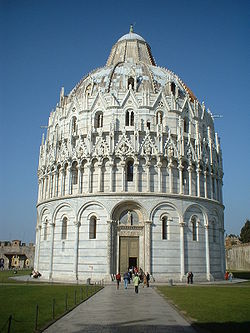
The Baptistery
Baptistery
In Christian architecture the baptistry or baptistery is the separate centrally-planned structure surrounding the baptismal font. The baptistry may be incorporated within the body of a church or cathedral and be provided with an altar as a chapel...
, dedicated to St. John the Baptist, stands opposite the west end of the Duomo. The round Romanesque building was begun in the mid 12th century: 1153 Mense August fundata fuit haec ("In the month of August 1153 was set up here..."). It was built in Romanesque
Romanesque architecture
Romanesque architecture is an architectural style of Medieval Europe characterised by semi-circular arches. There is no consensus for the beginning date of the Romanesque architecture, with proposals ranging from the 6th to the 10th century. It developed in the 12th century into the Gothic style,...
style by an architect
Architect
An architect is a person trained in the planning, design and oversight of the construction of buildings. To practice architecture means to offer or render services in connection with the design and construction of a building, or group of buildings and the space within the site surrounding the...
known as Diotisalvi
Diotisalvi
Diotisalvi, Deotisalvi or Deustesalvet was an architect from Pisa, Italy, active in the 12th century in Pisa. Little is known of him.- Biography :...
("God Save You"), who worked also in the church of the Holy Sepulchre
Santo Sepolcro (Pisa)
The Church of the Santo Sepolcro is a religious edifice in Pisa, Tuscany, Italy....
in the city. His name is mentioned on a pillar inside, as Diotosalvi magister. the construction was not, however, finished until the 14th century, when the loggia
Loggia
Loggia is the name given to an architectural feature, originally of Minoan design. They are often a gallery or corridor at ground level, sometimes higher, on the facade of a building and open to the air on one side, where it is supported by columns or pierced openings in the wall...
, the top storey and the dome were added in Gothic
Gothic architecture
Gothic architecture is a style of architecture that flourished during the high and late medieval period. It evolved from Romanesque architecture and was succeeded by Renaissance architecture....
style by Nicola Pisano
Nicola Pisano
Nicola Pisano was an Italian sculptor whose work is noted for its classical Roman sculptural style. Pisano is sometimes considered to be the founder of modern sculpture.- Early life :His birth date or origins are uncertain...
and Giovanni Pisano
Giovanni Pisano
Giovanni Pisano was an Italian sculptor, painter and architect. Son of the famous sculptor Nicola Pisano, he received his training in the workshop of his father....
.
It is the largest baptistery
Baptistery
In Christian architecture the baptistry or baptistery is the separate centrally-planned structure surrounding the baptismal font. The baptistry may be incorporated within the body of a church or cathedral and be provided with an altar as a chapel...
in Italy. Its circumference measures 107.25 m. Taking into account the statue of St. John the Baptist (attributed to Turino di Sano) on top of the dome, it is even a few centimetres higher than the Leaning Tower.
The portal, facing the façade of the cathedral, is flanked by two classical columns, while the inner jambs are executed in Byzantine
Byzantine architecture
Byzantine architecture is the architecture of the Byzantine Empire. The empire gradually emerged as a distinct artistic and cultural entity from what is today referred to as the Roman Empire after AD 330, when the Roman Emperor Constantine moved the capital of the Roman Empire east from Rome to...
style. The lintel is divided in two tiers. The lower one depicts several episodes in the life of St. John the Baptist, while the upper one shows Christ between the Madonna and St John the Baptist, flanked by angels and the evangelists.
The immensity of the interior is overwhelming, but it is surprisingly plain and lacks decoration. It has notable acoustics
Acoustics
Acoustics is the interdisciplinary science that deals with the study of all mechanical waves in gases, liquids, and solids including vibration, sound, ultrasound and infrasound. A scientist who works in the field of acoustics is an acoustician while someone working in the field of acoustics...
also.
The octagonal font
Baptismal font
A baptismal font is an article of church furniture or a fixture used for the baptism of children and adults.-Aspersion and affusion fonts:...
at the centre dates from 1246 and was made by Guido Bigarelli da Como. The bronze sculpture of St. John the Baptist at the centre of the font, is a remarkable work by Italo Griselli.
The pulpit was sculpted between 1255-1260 by Nicola Pisano
Nicola Pisano
Nicola Pisano was an Italian sculptor whose work is noted for its classical Roman sculptural style. Pisano is sometimes considered to be the founder of modern sculpture.- Early life :His birth date or origins are uncertain...
, father of Giovanni Pisano
Giovanni Pisano
Giovanni Pisano was an Italian sculptor, painter and architect. Son of the famous sculptor Nicola Pisano, he received his training in the workshop of his father....
, the artist who produced the pulpit in the Duomo. The scenes on the pulpit, and especially the classical form of the naked Hercules
Hercules
Hercules is the Roman name for Greek demigod Heracles, son of Zeus , and the mortal Alcmene...
, show at best Nicola Pisano's qualities as the most important precursor of Italian renaissance sculpture by reinstating antique representations. Therefore, surveys of the Italian Renaissance usually begin with the year 1260, the year that Nicola Pisano dated this pulpit.
Bell Tower
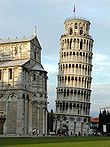
The campanile (bell tower
Bell tower
A bell tower is a tower which contains one or more bells, or which is designed to hold bells, even if it has none. In the European tradition, such a tower most commonly serves as part of a church and contains church bells. When attached to a city hall or other civic building, especially in...
) is located behind the cathedral. The last of the three major buildings on the piazza to be built, construction of the bell tower began in 1173 and took place in three stages over the course of 177 years, with the bell-chamber only added in 1372. Five years after construction began, when the building had reached the third floor level, the weak subsoil and poor foundation led to the building sinking on its south side. The building was left for a century, which allowed the subsoil to stabilise itself and prevented the building from collapsing. In 1272, to adjust the lean of the building, when construction resumed, the upper floors were built with one side taller than the other. The seventh and final floor was added in 1319. By the time the building was completed, the lean was approximately 1 degree, or 2.5 feet (80 cm) from vertical. At its greatest, measured prior to 1990, the lean measured approximately 5.5 degrees. As of 2010, this has been reduced to approximately 4 degrees.
The tower stands approximately 60m high, and was built to accommodate a total of seven main bells, cast to the musical scale
Musical scale
In music, a scale is a sequence of musical notes in ascending and descending order. Most commonly, especially in the context of the common practice period, the notes of a scale will belong to a single key, thus providing material for or being used to conveniently represent part or all of a musical...
:
- 1st bell (clockwise): L'Assunta, cast in 1654 by Giovanni Pietro Orlandi, weight 3,620 kg (7,981 lb)
- 2nd bell: Il Crocifisso, cast in 1572 by Vincenzo Possenti, weight 2,462 kg (5,428 lb)
- 3rd bell: San Ranieri, cast in 1719-1721 by Giovanni Andrea Moreni, weight 1,448 kg (3,192 lb)
- 4th bell: La Terza (1st small one), cast in 1473, weight 300 kg (661 lb)
- 5th bell: La Pasquereccia or La Giustizia, cast in 1262 by Lotteringo, weight 1,014 kg (2,235 lb)
- 6th bell: Il Vespruccio (2nd small one), cast in the 14th century and again in 1501 by Nicola di Jacopo, weight 1,000 kg (2,205 lb)
- 7th bell: Dal PozzoCarlo Antonio Dal PozzoCarlo Antonio Dal Pozzo was an Italian prelate, who was archbishop metropolita of the Pisa Diocese.He came from the noble family of Dal Pozzo Della Cisterna of Biella...
, cast in 1606 and again in 2004, weight 652 kg (1,437 lb) - Number of steps to the top: 296
Campo Santo
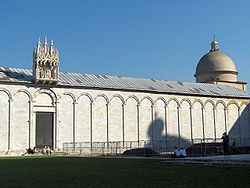
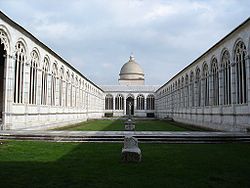
Cemetery
A cemetery is a place in which dead bodies and cremated remains are buried. The term "cemetery" implies that the land is specifically designated as a burying ground. Cemeteries in the Western world are where the final ceremonies of death are observed...
, which many claim is the most beautiful cemetery in the world. It is said to have been built around a shipload of sacred soil from Golgotha, brought back to Pisa from the Fourth Crusade
Fourth Crusade
The Fourth Crusade was originally intended to conquer Muslim-controlled Jerusalem by means of an invasion through Egypt. Instead, in April 1204, the Crusaders of Western Europe invaded and conquered the Christian city of Constantinople, capital of the Eastern Roman Empire...
by Ubaldo de' Lanfranchi, archbishop of Pisa in the 12th century, hence the name "Campo Santo" (Holy Field).
The building itself dates from a century later and was erected over the earlier burial ground. The building of this huge, oblong Gothic cloister
Cloister
A cloister is a rectangular open space surrounded by covered walks or open galleries, with open arcades on the inner side, running along the walls of buildings and forming a quadrangle or garth...
began in 1278 by the architect Giovanni di Simone. He died in 1284 when Pisa suffered a defeat in a naval battle of Meloria
Battle of Meloria (1284)
The Battle of Meloria was fought between 5 and 6 August 1284 near the Meloria islet, in the Tyrrhenian Sea between the Genoese and the Pisan fleet, as part of the Genoese-Pisan War...
against the Genoans. The cemetery was only completed in 1464. The outer wall is composed of 43 blind arches. There are two doorways. The one on the right is crowned by a gracious Gothic tabernacle. It contains the Virgin Mary with Child, surrounded by four saints. It is the work from the second half of the 14th century by a follower of Giovanni Pisano
Giovanni Pisano
Giovanni Pisano was an Italian sculptor, painter and architect. Son of the famous sculptor Nicola Pisano, he received his training in the workshop of his father....
. Most of the tombs are under the arcades, although a few are on the central lawn. The inner court is surrounded by elaborate round arches with slender mullion
Mullion
A mullion is a vertical structural element which divides adjacent window units. The primary purpose of the mullion is as a structural support to an arch or lintel above the window opening. Its secondary purpose may be as a rigid support to the glazing of the window...
s and plurilobed tracery
Tracery
In architecture, Tracery is the stonework elements that support the glass in a Gothic window. The term probably derives from the 'tracing floors' on which the complex patterns of late Gothic windows were laid out.-Plate tracery:...
.
It contained a huge collection of Roman sculptures and sarcophagi
Sarcophagus
A sarcophagus is a funeral receptacle for a corpse, most commonly carved or cut from stone. The word "sarcophagus" comes from the Greek σαρξ sarx meaning "flesh", and φαγειν phagein meaning "to eat", hence sarkophagus means "flesh-eating"; from the phrase lithos sarkophagos...
, but now there are only 84 left. The walls were once covered in fresco
Fresco
Fresco is any of several related mural painting types, executed on plaster on walls or ceilings. The word fresco comes from the Greek word affresca which derives from the Latin word for "fresh". Frescoes first developed in the ancient world and continued to be popular through the Renaissance...
es, the first were applied in 1360, the last about three centuries later. The Stories of the Old Testament by Benozzo Gozzoli
Benozzo Gozzoli
Benozzo Gozzoli was an Italian Renaissance painter from Florence. He is best known for a series of murals in the Palazzo Medici-Riccardi depicting festive, vibrant processions with wonderful attention to detail and a pronounced International Gothic influence.-Apprenticeship:He was born Benozzo di...
(15th century) were situated in the north gallery, while the south arcade was famous for the Stories of the Genesis by Piero di Puccio
Piero di Puccio
Piero di Puccio was a fourteenth century Italian painter of the Gothic period, active mainly in Orvieto. He is also known as Pietro di Puccio. He painted a fresco of stories from Genesis, from the Creation to the Deluge on the North wall of Campo Santo in Pisa. The fresco was devastated during the...
(end 15th century). The most remarkable fresco is the realistic The Triumph of Death, the work of Buonamico Buffalmacco
Buonamico Buffalmacco
Buonamico di [son of] Martino or Buonamico Buffalmacco was an Italian painter who worked in Florence, Bologna and Pisa...
. But on 27 July 1944 incendiary bombs dropped by Allied aircraft set the roof on fire and covered them in molten lead, all but destroying them. Since 1945 restoration works have been going on and now the Campo Santo has been brought back to its original state.
The Spedale Nuovo di Santo Spirito
On the southest edge of the square there is the building of Spedale Nuovo di Santo Spirito ("New Hospital of Holy Spirit") built in 1257 by Giovanni di Simone maybe over a preexisting hospital. The function of this hospital was to help pilgrims, poor, sick people and abandoned children with a shelter. It later changed its name in Spedale della Misericordia ("Hospital of the Mercy") or di Santa Chiara ("Sant Claire") that was the name of the little church included in the complex.The exterior was in brick walls with two-light windows in gothic style, whereas the interior was painted in two colors, black and white, to imitate the marble colors of the other buildings.
During the Medici domination of the city, in 1562, the hospital was restructured according to Florentine renaissance canons: all the doors and windows were modified with new rectangular ones encased in gray sandstone.
Nowadays the building is no more an hospital. In the middle part of it, since 1979 is host the Museum of Sinopias where are kept the original drawings of the Camposanto frescoes.
Sources
External links
- Official website
- Photo gallery
- Field of Miracles
- Interactive High resolution 360° Panoramic Photo of Piazza dei Miracoli Virtual Tour by Hans von Weissenfluh
- Piazza dei Miracoli digital media archive (creative commonsCreative CommonsCreative Commons is a non-profit organization headquartered in Mountain View, California, United States devoted to expanding the range of creative works available for others to build upon legally and to share. The organization has released several copyright-licenses known as Creative Commons...
-licensed photos, laser scans, panoramas), data from a University of FerraraUniversity of FerraraThe University of Ferrara is the main university of the city of Ferrara in the Emilia-Romagna region of northern Italy. In the years prior to the First World War the University of Ferrara, with more than 500 students, was the best attended of the free universities in Italy...
/CyArkCyArkCyArk is a 501 nonprofit organization located in Oakland, California, United States. The company's website refers to it as a "digital archive of the world’s heritage sites for preservation and education"...
research partnership.

